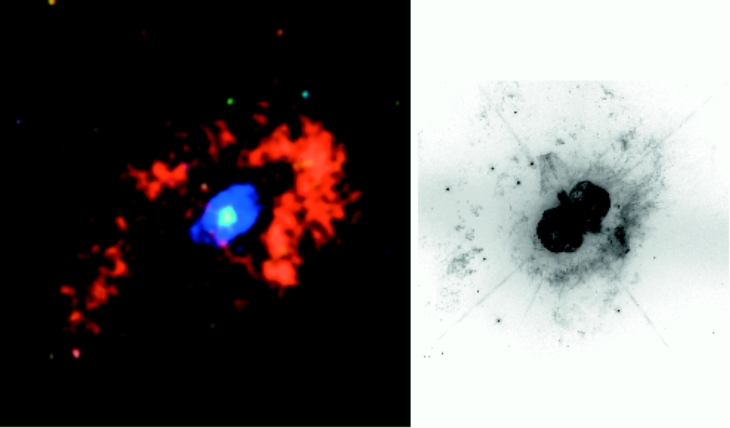
 Credit: (left) M. F. Corcoran et al.; Chandra X-ray Observatory; NASA; (right) N. Smith et al.; Hubble Space Telescope
Credit: (left) M. F. Corcoran et al.; Chandra X-ray Observatory; NASA; (right) N. Smith et al.; Hubble Space Telescope
Reflections on a Little Man
The supermassive star Eta Carinae is surrounded by a bipolar nebula of gas and dust. This nebula is called the Homunculus because of its apparent similarity in ground-based telescopes to a small humanoid. The nebula is quite bright in infrared (heat) emission and rather bright optically, but relatively faint at higher energies of radiation. Though Eta Carinae itself is quite bright at ultraviolet and X-ray wavelengths, each 5.5 years, the ultraviolet and X-ray emission from the star seems to fade. During the last fading, at the end of last summer, the Chandra X-ray observatory took the image seen above left. In this X-ray image the central source is very faint but still visible as a blue-with dot near the center of the image. Surprisingly, this source was surrounded by a blue haze which is nearly identical in shape and orientation to optical images of the Homunculus, such as the one on the above right (obtained by the Hubble Space Telescope). Astronomers believe the bluish haze is produced by the time-delayed reflection of X-rays produced near Eta Carinae off gas in the walls of the Homunculus.
Last Week *
HEA Dictionary * Archive
* Search HEAPOW
* Education
Each week the HEASARC
brings you new, exciting and beautiful images from X-ray and Gamma ray
astronomy. Check back each week and be sure to check out the HEAPOW archive!
Last modified Tuesday, 27-Feb-2024 10:10:08 EST


